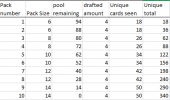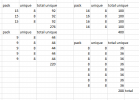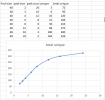I'm sure there's a thread for this already so if some mod wants to merge this discussion in with that, be my guest.
Some of us were having a discussion on the Brainstorming discord today about pack size for a traditional 8 player draft, some folks like the traditional 15 cards x 3 per player, I'm a special snowflake and run 4 packs of 16, I know some folks have tried the 20 card packs thing that wotc broke out in commander legends; blah blah blah lots of options.
Which method do you like most? Have you tried others that you found worked well? Have any been super shitty? Why?
@landofMordor even asked the question today "why do packs need to wheel at all?" and it's gotten me thinking about trying a switch to 8 packs of 8! Interested to hear what you nerds think.
Some of us were having a discussion on the Brainstorming discord today about pack size for a traditional 8 player draft, some folks like the traditional 15 cards x 3 per player, I'm a special snowflake and run 4 packs of 16, I know some folks have tried the 20 card packs thing that wotc broke out in commander legends; blah blah blah lots of options.
Which method do you like most? Have you tried others that you found worked well? Have any been super shitty? Why?
@landofMordor even asked the question today "why do packs need to wheel at all?" and it's gotten me thinking about trying a switch to 8 packs of 8! Interested to hear what you nerds think.



